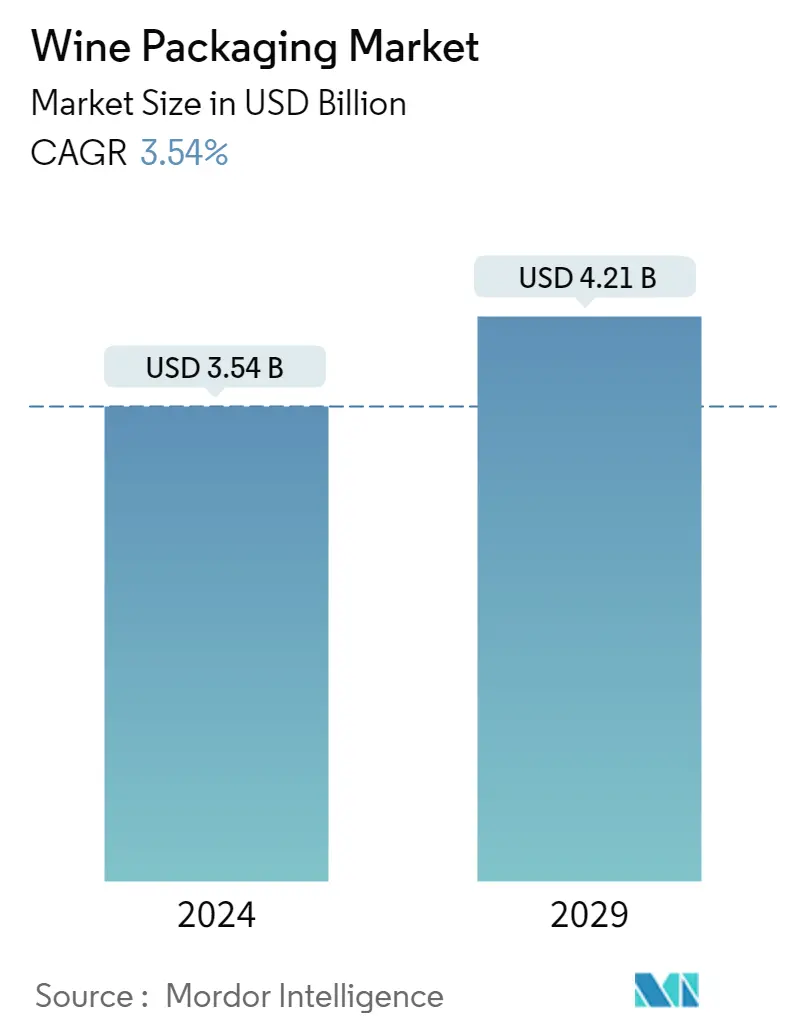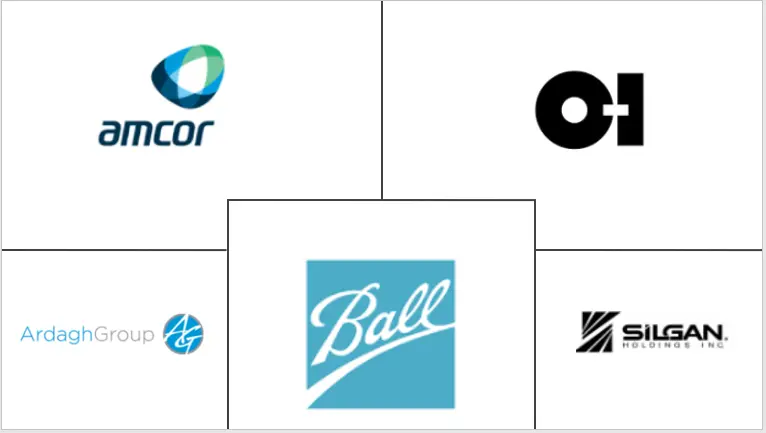Market Size of Wine Packaging Industry

| Study Period | 2019 - 2029 |
| Base Year For Estimation | 2023 |
| Market Size (2024) | USD 3.54 Billion |
| Market Size (2029) | USD 4.21 Billion |
| CAGR (2024 - 2029) | 3.54 % |
| Market Concentration | Medium |
Major Players
*Disclaimer: Major Players sorted in no particular order |
United States Wine Packaging Market Analysis
The Wine Packaging Market size is estimated at USD 3.54 billion in 2024, and is expected to reach USD 4.21 billion by 2029, growing at a CAGR of 3.54% during the forecast period (2024-2029).
With the consumer demand for smaller packaging, the wine packaging market in the United States is witnessing the adoption of non-glass bottle-based alternatives such as bags in boxes, pouches, cans, paper bottles, among others.
- With the COVID-19 pandemic, the wine packaging market in the United States is expected to witness growth. Also, wine packaging manufacturers have been flooded with a pool of issues that are expected to persist for the short-term. Some of the effects of lockdown include the lack of availability of raw materials used in the manufacturing process, supply chain disruptions, fluctuating prices, and labor shortages that could cause shipping problems, and production of the final product to inflate and go beyond budget, etc.
- The wine packaging popularity in the region is vastly dependent on consumer age and usages. For example, for events like music festivals, friendly gatherings, and sports games, cans, pouches, and small bag-in-a-box are gaining popularity among consumers.
- Packaging such as bags in boxes (BIB) weighs less than glass bottles. They don't break and can be sealed at any time. In addition, it offers benefits such as low logistics costs and ease of transport, large print area for marketing purposes, (to manufacturers) ideal stacking capacity, and saves space. It also saves purchasing and transportation costs to the bulk purchaser. It is up to 40% less expensive than wine in glass bottles (to end consumers) and have recycling and upcycling options.
- The manufacturers in the wine packaging market are constantly innovating and developing new packaging products to gain a competitive advantage in the market.
- Amcor launched Easypeel that uses a one-piece aluminum capsule engineered to open wine bottles along a clean line. Unlike other technologies that depend on pull tabs, EASYPEEL allows consumers and professionals to use traditional bottle openers.
United States Wine Packaging Industry Segmentation
The wine packaging market uses various materials and product types for the packaging of wines. Segmentation is done the basis of material (glass, metal, paper, etc.) and product type (Glass bottles, Plastic bottles, Bag in Box, etc)
| Material | |
| Plastic | |
| Paper | |
| Glass | |
| Other Materials |
| Product Type | |
| Glass Bottles | |
| Plastic Bottles | |
| Bag In Box | |
| Closures | |
| Other Product Types |
Wine Packaging Market Size Summary
The United States wine packaging market is experiencing a shift towards innovative and sustainable packaging solutions, driven by changing consumer preferences and the impact of the COVID-19 pandemic. The demand for smaller, non-glass packaging alternatives such as bags in boxes, pouches, cans, and paper bottles is on the rise, offering benefits like reduced logistics costs, ease of transport, and environmental sustainability. These alternatives are gaining popularity for events and casual gatherings, where their portability and shatterproof nature are advantageous. Despite the dominance of glass packaging, which remains preferred for its compatibility with wine, the market is seeing increased competition and innovation as manufacturers strive to meet evolving consumer demands and regulatory pressures.
The market landscape is moderately fragmented, with key players like Ball Corporation, AMCOR PLC, Ardagh Group, Silgan Holdings Inc., and Owens-Illinois Inc. actively investing in new technologies and sustainable materials. The ongoing trade tensions and tariff implications on imported glass bottles from China are prompting manufacturers to enhance domestic production capabilities. Innovations such as bio-based caps and flat wine bottles made from post-consumer recycled PET plastic are examples of the industry's commitment to sustainability and cost-effectiveness. The market's growth trajectory is supported by strategic expansions and collaborations, aiming to streamline supply chains and introduce eco-friendly packaging solutions to the U.S. market.
Wine Packaging Market Size - Table of Contents
-
1. MARKET INSIGHTS
-
1.1 Market Overview
-
1.2 Industry Value Chain Analysis
-
1.3 Market Drivers
-
1.3.1 Emergence of non-glass bottle-based alternatives
-
1.3.2 Innovations in packaging
-
-
1.4 Market Challenges
-
1.4.1 Dynamic nature of material-related regulations
-
-
1.5 Industry Attractiveness - Porter's Five Forces Analysis
-
1.5.1 Threat of New Entrants
-
1.5.2 Bargaining Power of Suppliers
-
1.5.3 Bargaining Power of Consumers
-
1.5.4 Threat of Substitute Products
-
1.5.5 Intensity of Competitive Rivalry
-
-
1.6 Major innovations in Wine Packaging
-
-
2. MARKET SEGMENTATION
-
2.1 Material
-
2.1.1 Plastic
-
2.1.2 Paper
-
2.1.3 Glass
-
2.1.4 Other Materials
-
-
2.2 Product Type
-
2.2.1 Glass Bottles
-
2.2.2 Plastic Bottles
-
2.2.3 Bag In Box
-
2.2.4 Closures
-
2.2.5 Other Product Types
-
-
Wine Packaging Market Size FAQs
How big is the Wine Packaging Market?
The Wine Packaging Market size is expected to reach USD 3.54 billion in 2024 and grow at a CAGR of 3.54% to reach USD 4.21 billion by 2029.
What is the current Wine Packaging Market size?
In 2024, the Wine Packaging Market size is expected to reach USD 3.54 billion.

